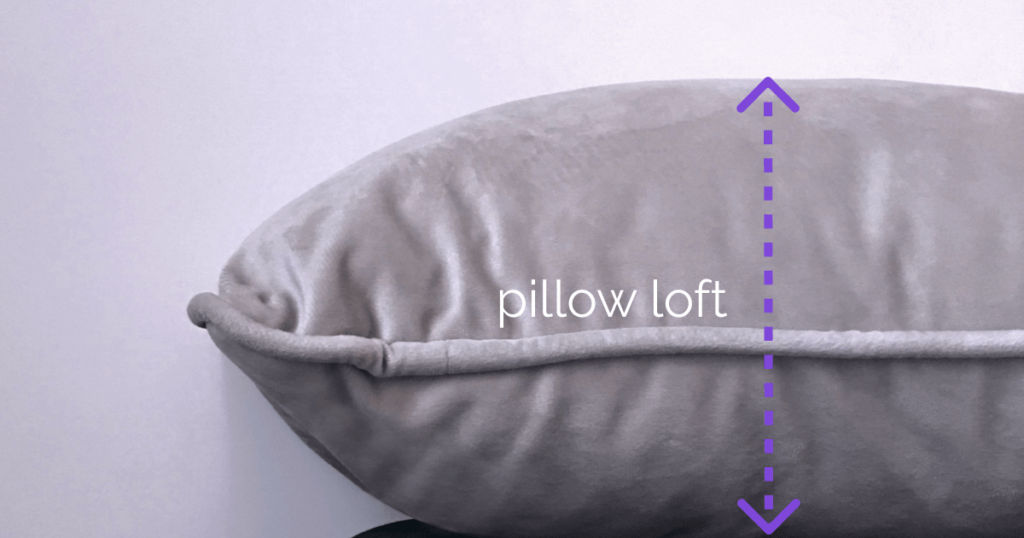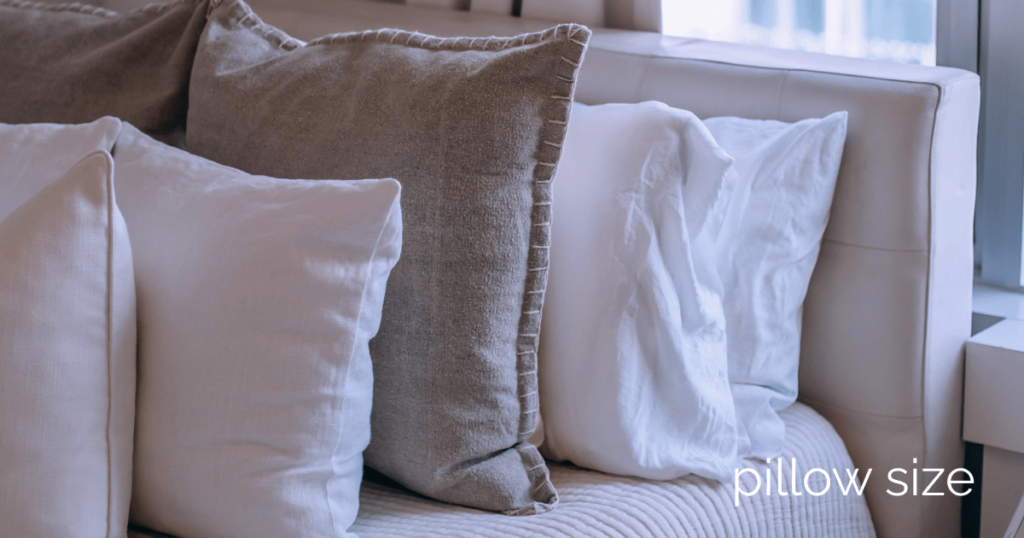If you’re tossing and turning, waking up with a sore neck, or just can’t get comfortable, your pillow might be the problem. Yes, pillows can’t hurt your feelings, but they can definitely hurt your health. But don’t worry—I’ve got you covered!
In this guide on how to choose a pillow, I’ll walk you through 5 important criteria you should know to help you pick the perfect one.
Why Choosing the Right Pillow Matters
We spend about a third of our lives sleeping, so it’s no wonder the quality of our sleep affects how we feel when we’re awake. The right pillow does more than just provide comfort; it also:
- Helps align your spine
- Supports your head and neck
- Promotes better breathing during sleep
- Prevents morning headaches
- Improves your overall sleep quality
Sounds great, right? Let’s dive into the 5 key criteria to help you choose a pillow that’s right for you!
How to Choose a Pillow: 5 Key Criteria to Get It Right
1. Consider Your Sleep Position

Your sleeping position is one of the most important factors in choosing a pillow. Different positions require different levels of support, and a mismatch here can lead to discomfort. Here’s a quick breakdown:
- Back Sleepers:
- Ideally for back sleepers, a pillow with medium loft (around three to four inches) and medium firmness strikes the perfect balance. It prevents your head from tilting forward or sinking too low, helping to maintain a neutral spine alignment. It also creates a healthier body position that reduces muscle strain, alleviates neck pain, and promotes open airways, allowing for smoother breathing throughout the night.
- Recommended read: 7 Best Pillows for Back Sleepers: Pillows That Got Your Back
- Side Sleepers
- Side sleepers naturally create a gap between their head, neck, and the mattress due to their sleeping position. A mid to high loft pillow, ideally about five to six inches thick, fills this space, so your head and neck are properly supported. Without this, your head tilts downward, straining your neck and throwing your spine out of alignment.
- A higher loft keeps everything in line, reducing pressure on your neck and shoulders.
- Recommended read: 5 Best Pillows for Side Sleepers: Customer-Recommended for Comfort and Support
- Stomach Sleepers
- If you’re a stomach sleeper, you’ll need a soft, flat pillow. With a flat pillow, your head stays closer to the mattress, reducing pressure on your neck and keeping your spine more aligned.
- Sleeping on your stomach naturally puts your neck in a tricky position since it’s often twisted to one side. A thick pillow can push your head too far back, making that strain worse and causing discomfort.
- Tip: If you’re feeling sore in the morning, it might be worth trying to switch up your sleep position. I know it’s hard to change habits, but side sleeping tends to be better for your spine and neck.
- Recommended read: 5 Best Pillows for Stomach Sleepers: Top Pillow Choices for Comfort and Support
Not Sure What Type of Sleeper You Are?
Not sure where to start? Pay attention to how you wake up in the morning. If you’re most comfortable on your side, that’s a good place to start. Your wake-up position can give you some clues about your natural sleep habits, which can help you choose the right pillow faster.
2. How to Choose Pillow Material (Fill)

Picking the right pillow material is just as important as finding the right size and firmness. Each material comes with its own benefits and drawbacks, so let’s break them down to help you find the best one for your needs:
Memory foam pillows are known for their ability to mold perfectly to your head and neck, providing excellent support and pressure relief. Ideal for those with neck or back pain.
- Pros:
- Contours to your shape for personalized support
- Ideal for relieving neck and back pain
- Durable and holds its shape over time
- Cons:
- Can trap heat
- Tip:
- Choose gel-infused or ventilated memory foam to help regulate temperature and stay cool throughout the night.
Down and feather pillows offer a soft, plush feel that’s perfect for those who like to sink into their pillows. Great for anyone who loves a luxurious, moldable option.
- Pros:
- Soft and plush
- Moldable and easy to fluff
- Lightweight and breathable
- Cons:
- Can trigger allergies for some people
- Tip:
- Opt for hypoallergenic down alternatives to avoid triggering your allergies.
Latex pillows are a fantastic option if you’re looking for a firm, supportive pillow that keeps its shape. Perfect for those who prefer a bouncy feel and want an eco-friendly choice.
- Pros:
- Firm and supportive without losing shape
- Naturally hypoallergenic and dust-mite resistant
- Stays cooler than memory foam
- Cons:
- Higher price point than other materials
- Tip:
- Try a blended latex pillow for a balance of firmness and softness.
Polyester pillows are a budget-friendly and widely available option. Ideal for those seeking a soft, affordable and lightweight pillow.
- Pros:
- Affordable and easy to find
- Lightweight and soft
- Good short-term or backup option
- Cons:
- Flattens quickly and loses support
- Not as durable as other materials
- Tip:
- Consider replacing polyester pillows regularly for consistent comfort.
Cotton-filled pillows are a natural and breathable option, great for hot sleepers or those with sensitive skin.
- Pros:
- Breathable and cool
- Hypoallergenic and resistant to dust mites
- Natural and environmentally friendly
- Generally lasts longer than cheaper synthetic options
- Cons:
- Can flatten over time
- May lack the softness of other materials
- Tip:
- To maintain the firmness of a cotton pillow, fluff it regularly and air it out to extend its lifespan.
If you’re looking for something unique, buckwheat pillows might be the answer. Perfect for those who want adjustable, firm support and excellent airflow.
- Pros:
- Adjustable firmness by adding or removing hulls
- Breathable and cool
- Naturally hypoallergenic
- Cons:
- Noisy when shifting
- Heavier than other pillows
- Tip:
- If noise bothers you, use a padded pillowcase to muffle the noise from the hulls.
Kapok is a natural fiber that feels like down, making it a great eco-friendly alternative. Ideal for those who prefer a soft, down-like feel.
- Pros:
- Soft and lightweight
- Eco-friendly and sustainable
- Hypoallergenic and breathable
- Cons:
- Can flatten over time
- Tip:
- Choose a kapok blend with firmer materials if you need extra support.
Gel-infused pillows combine materials like memory foam or polyester with cooling gel to help regulate temperature. Best for hot sleepers who want the support of memory foam without the heat.
- Pros:
- Stays cool throughout the night, great for hot sleepers.
- Provides memory foam-like support
- Cons:
- Higher cost than standard pillows
- Tip:
- Try shredded gel memory foam for a softer option.
Wool pillows offer excellent temperature regulation and are naturally moisture-wicking, keeping you cool in the summer and warm in the winter. Great for those who want a firm, durable option.
- Pros:
- Great temperature regulation year-round
- Moisture-wicking and hypoallergenic
- Firm and durable
- Cons:
- Pricey
- Tip:
- Go for wool blends if you want more comfort while keeping the firmness.
3. How to Choose Pillow Loft (Height)

The loft refers to the height or thickness of the pillow. The right loft depends on your sleep position, body size, and mattress firmness.
- Low Loft (less than 3 inches): Best for stomach sleepers and back sleepers who prefer minimal elevation.
- Medium Loft (3 to 5 inches): Works well for most back sleepers.
- High Loft (over 5 inches): Ideal for side sleepers who need that extra height to fill the gap between their head and shoulder.
4. How to Choose Pillow Firmness

Pillow firmness impacts how much support you get during sleep. Here’s how to decide:
- Soft: Soft pillows are best for stomach sleepers or those who prefer a plush, sinking feeling. Materials like down and feather, kapok, and polyester are great for achieving this softness.
- Medium: Medium-firm pillow, which is ideal for back sleepers or those who want a balance between soft and firm, consider materials such as memory foam, gel-infused foam, or blended latex.
- Firm: Firm pillow, which is perfect for side sleepers or anyone who needs extra support for their neck and shoulders, materials like latex, buckwheat, or wool provide the right level of firmness and stability.
5. How to Choose Pillow Size

Size matters when picking the right pillow, as it can greatly impact your comfort and how it fits with your bed. Here’s how I break it down:
- Standard Size: This is the go-to size for most sleepers. It’s compact, versatile, and works perfectly if you sleep solo or have a smaller bed like a twin or full-size.
- Queen Size: If you tend to toss and turn, or just want a little extra room, the queen size is a great choice. It’s got the length to keep up with you and pairs well with queen-size beds.
- King Size: For those of you who need maximum space—whether you’re a restless sleeper or just like a bigger pillow—king-size pillows are perfect. They provide full head and neck support, especially if you’ve got a king or California king bed.
For deeper insights, our article What Size Is a Standard Pillow? Your Number 1 Guide to Pillow Sizes for Better Sleep covers this topic thoroughly.
Test Your Pillow Choice
Once you’ve narrowed down your choices, it’s time to test your pillow. Ideally, you want to try out the pillow for a few nights to see how your body reacts. Many companies offer trial periods where you can sleep on the pillow and return it if it’s not a good fit. At Pillow Cupid, we always recommend giving it a good trial run — your body needs time to adjust to a new pillow!
If possible, test the pillow in-store by lying down in your usual sleep position to see how it feels. Remember, it’s all about comfort and support!
Pillow Maintenance Tips: How to Keep Your Pillow Fresh
Now that you’ve found your perfect pillow match, it’s important to keep it clean and in good shape! Here’s how:
- Wash regularly: Most pillows can be washed every 4-6 months (check the care instructions). Use a gentle cycle and mild detergent.
- Use a pillow protector: This helps extend the life of your pillow and keeps it free from allergens, dust, and sweat.
- Fluff it up: To keep your pillow from going flat, give it a good fluff every few days. You can also toss it in the dryer on low heat for 10 minutes.
- Replace your pillow: Over time, pillows lose their shape and support. A good rule of thumb is to replace your pillow every 18-24 months, depending on the material.
Curious about more ideas on taking care of your pillows? Check these blog posts: How to Wash a Pillow: 4 Easy Steps to Revitalize Your Pillows, How to Wash Memory Foam Pillow: Quick Clean, Deep Clean, and Stain Removal Guide, and How to Fluff a Pillow: 3 Effective Methods for a Comfy Night’s Sleep.
When to Replace Your Pillow
I know it’s easy to hang on to your favorite pillow forever, but pillows don’t last forever. Here’s how to know when it’s time to replace yours:
- Losing Shape: If your pillow has gone flat or doesn’t bounce back after fluffing, it’s time to swap it out.
- Neck Pain: If you wake up with neck or shoulder pain that wasn’t there before, your pillow might not be giving you the support it once did.
- Allergies Acting Up: Over time, pillows collect dust mites and allergens. If you’re sneezing more in bed, it could be a sign your pillow needs replacing.
- Lumps and Bumps: If your pillow has developed lumps that don’t smooth out, it’s a sign the material is breaking down.
- Stains and Odors: Any visible stains or unpleasant odors can indicate that your pillow is harboring bacteria or moisture. If washing doesn’t help, it’s time for a new one.
As a general rule, replace your pillow every 1-2 years to ensure you’re getting the right support and a fresh, clean sleeping surface.
Conclusion: How to Choose a Pillow
Choosing the right pillow doesn’t have to be complicated. By following these 5 key criteria on how to choose a pillow—your sleep position, pillow material, loft, firmness, and size—you’re well on your way to better sleep. Remember, finding the right pillow can make all the difference in your comfort and how you feel every morning.
The right pillow is out there, and Pillow Cupid is always here to help you learn how to choose a pillow that fits your needs!

